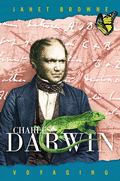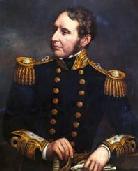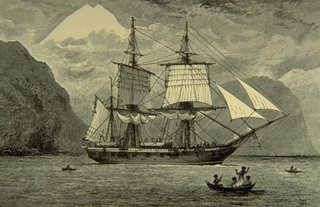Partial Book Report on Janet Browne’s “Voyaging” or "The Dog Ate My Homework."

I’ve been reading Janet Browne’s book “Voyaging”, the first of a two-book bio of Mr. Darwin’s life and work (see the reading list in one of my earlier blog entries). Anyway, I don’t get much opportunity to read – usually only and hour or so before bed most nights. Like an excuse to my elementary school teacher, “this is why I’m only half-way through the book.” I’ve just arrived at the point in the book where the H.M.S. Beagle landed in the Galapagos Islands.
I’ve been blown away thus far with Ms. Browne’s work. Her research and through knowledge of the subject matter paints a rich and detailed picture of Mr. Darwin – possibly too “rich” for some readers who aren’t interested in the myriad of details being woven into a life “well-lived”.
However, the details to me are important because they begin to show how Mr. Darwin is really is a summation of the efforts and interests of many individuals, Mr. Darwin included.

One particular point that stands out and is unknown or misunderstood by most people is that Mr. Darwin was NOT selected to serve as the “Naturalist” onboard the H.M.S. Beagle. He was chosen only to be Captain’s Fitzroy’s (pictured at left) “companion”. Due to 19th century social stratification, if it were no for Darwin, Captain Fitzroy would have had no one to interact with during the voyage because of his social status. Also, because Mr. Darwin paid his own way throughout the Beagle voyage, whatever samples he collected were his personal property not the property of the crown. At this time natural history collections and samples were worth their weight in gold – they were in very high demand by both institutions and private “collectors”. According the Browne, the net total of drafts he requested from his father was just short of 1,200 British pounds – it’s a very expensive endeavor being a “gentleman-naturalist.”

A majority of this cost was due to land excursions taken at many points during the voyage. Mr. Darwin was away from home for a total of five (5) years, but only 18 months of this was at sea aboard the Beagle. The usual ocean run was between 8 and 18 days with the longest single stretch onboard being 47 days. Amazing! Although most of us know of Mr. Darwin’s “voyage”, few of us know that the majority of this “voyage” took place on land. These extensive (sometimes up to four months) land expeditions were only possible because of Mr. Darwin’s privileged position onboard as Captain Fitzroy’s “campanion.”

0 Comments:
Post a Comment
<< Home